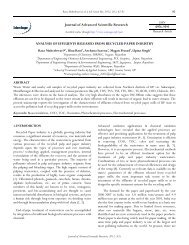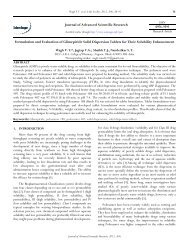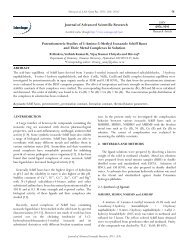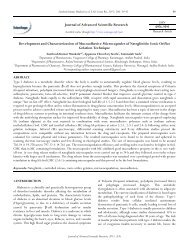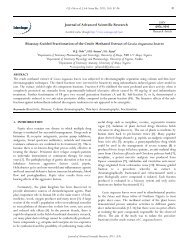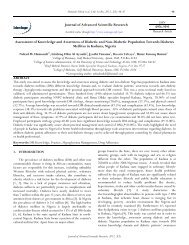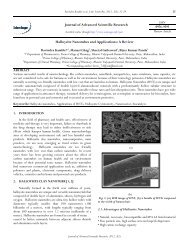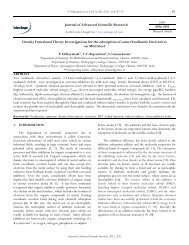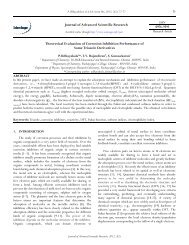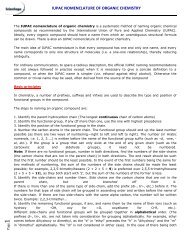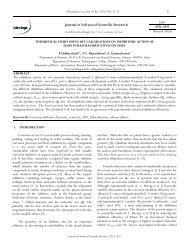Screening and optimization of L-Asparaginase - Sciensage.info
Screening and optimization of L-Asparaginase - Sciensage.info
Screening and optimization of L-Asparaginase - Sciensage.info
Create successful ePaper yourself
Turn your PDF publications into a flip-book with our unique Google optimized e-Paper software.
Available online through www.sciensage.<strong>info</strong><br />
<strong>Screening</strong> <strong>and</strong> Optimization <strong>of</strong> L-<strong>Asparaginase</strong>- A Tumour Inhibitor from<br />
Aspergillus terreus Through Solid State Fermentation<br />
ABSTRACT<br />
Thirty-five filamentous fungal isolates obtained from soil samples<br />
Siddalingeshwara Kalingapplar from different regions <strong>of</strong> Gulbarga, It was identified as Aspergillus<br />
Gurubasappa*<br />
terreus <strong>and</strong> screened for their ability to produce L-asparaginase.<br />
Lingappa Kattimani<br />
Department <strong>of</strong> studies in<br />
Using modified Czapek Dox agar containing L-asparagine <strong>and</strong><br />
Microbiology, Food <strong>and</strong><br />
phenol red as indicator, all thirty five L-asparaginase producing<br />
Fermentation Laboratory.<br />
fungal isolates could be preliminary identified by plate assay<br />
Gulbarga University, Gulbarga.<br />
method, observing pink colour formation. It was found that<br />
Karnataka. India<br />
Aspergillus terreus KLS2 exhibited highest activity. The<br />
*Corresponding Author:<br />
Aspergillus terreus KLS2 were used for <strong>optimization</strong> <strong>of</strong><br />
siddha_lingeshwar@rediffmail.com fermentation parameters like pH, temperature <strong>and</strong> inoculum size<br />
m<br />
for L-asparaginase production through solid state fermentation by<br />
using carob pod as a substrate. The pH 4.5, temperature 35 0 C <strong>and</strong><br />
Phone: 022-2755 0816<br />
1x10 7 spores /ml inoculum size were found optimum for maximum 6.05 IU <strong>of</strong> L-asparaginase production.<br />
Keywords: L-asparaginase, Solid state fermentation, Carob pod, Aspergillus terreus, Plate assay<br />
INTRODUCTION<br />
Journal <strong>of</strong> Advanced Scientific Research<br />
J. Adv. Sci. Res, 2010, 1(1); 55-60<br />
Published on 10th Aug 2010<br />
Copyright ©2010 by ScienSage Publications<br />
Research Article<br />
Enzymes produced by microorganisms have been used in various industries in the world. Microbial L-<br />
asparaginase (L-asparagine amido hydrolase, E.C.3.5.1.1) has been widely used as a therapeutic agent in the<br />
treatment <strong>of</strong> certain human cancers, mainly in acute lymphoblastic leukemia 1-2 . The discovery <strong>of</strong> L-<br />
asparaginase ,a medicinal agent for the treatment <strong>of</strong> malignant tumors, was made in 1922 3 .Clementi showed that<br />
guinea pig serum contained a high activity <strong>of</strong> L-asparaginase 3 . L-<strong>Asparaginase</strong> catalyses the conversion <strong>of</strong> l-<br />
asparagine to l-aspartate <strong>and</strong> ammonium, <strong>and</strong> this catalytic reaction is essentially irreversible under physiological<br />
conditions 4 .Supplementation <strong>of</strong> L-asparaginase results in continuous depletion <strong>of</strong> l-asparagine. Under such an<br />
environment, cancerous cells do not survive. This phenomenal behaviour <strong>of</strong> cancerous cells was exploited by the<br />
scientific community to treat neoplasias using L-asparaginase 5-7 .<br />
This enzyme is also a choice for acute lymphoblastic leukemia, lymphosarcoma <strong>and</strong> in many other clinical<br />
experiments relating to tumour therapy in combination with chemotherapy. This treatment brought a major<br />
breakthrough in modern oncology, as it induces complete remission in over 90% <strong>of</strong> children within 4 weeks 1 .<br />
With the development <strong>of</strong> its new functions, a great dem<strong>and</strong> for L-asparaginase is expected in the coming years.<br />
This enzyme is widely distributed, being found in L-asparaginase is widely distributed, being found in animal,<br />
microbial <strong>and</strong> plant sources 8 . It’s presence in guinea pig serum was first reported by Clementi 3 . Large number <strong>of</strong><br />
microorganisms that include Erwinia carotovora 9 , Pseudomonas stutzeri 10 , Pseudomonas aerugenosa 11 <strong>and</strong> E.<br />
coli 12 . It has been observed that eukaryotic microorganisms like yeast <strong>and</strong> fungi have a potential for asparaginase<br />
production. 13-14<br />
55 Siddalingeshwara et al./ J.Adv.Sci.Res.,2010, 1(1);55-60
Available online through www.sciensage.<strong>info</strong><br />
There were no reports on L-asparaginase production through solid state fermentation by using carob pod as a<br />
substrate. We made an attempt to screen for L-asparaginase producing microorganisms <strong>and</strong> <strong>optimization</strong> <strong>of</strong> L-<br />
asparaginase.<br />
MATERIALS AND METHODS<br />
Microorganism<br />
Aspergillus terreus isolated from different soil samples from various places from Gulbarga were used for the<br />
isolation <strong>of</strong> Aspergillus terreus strains as per the method <strong>of</strong> Seifert 15 . The isolated (Plate - 1) strains were<br />
tentatively identified in the laboratory as described by Rapper <strong>and</strong> Fennell 16 <strong>and</strong> were maintained on potato<br />
dextrose agar (PDA).<br />
Plate – 1: Aspergillus terreus<br />
<strong>Screening</strong> <strong>of</strong> L-Aspaerginase producer by plate assay<br />
The strains obtained from the above steps were subjected for rapid screening <strong>of</strong> L-asparaginase production by<br />
plate assay (Plate - 2) as per Gulati et al 17 .<br />
The modified Czapek Dox’s medium was supplemented with phenol red (2.5% prepared in ethanol <strong>and</strong> the pH<br />
was adjusted to 7.0) dye. The media was autoclaved <strong>and</strong> plates were prepared. Control plate was maintained<br />
without asparagine (instead containing NaNO 3 as nitrogen source).<br />
A<br />
B<br />
Plate – 2: Rapid Plate Assay for <strong>Screening</strong> <strong>of</strong> L-<strong>Asparaginase</strong> Producers<br />
A: Control, B: Assay Plate<br />
56 Siddalingeshwara et al./ J.Adv.Sci.Res.,2010, 1(1);55-60
Available online through www.sciensage.<strong>info</strong><br />
The plates were inoculated with Aspergillus terreus strains isolated from the soil. The zone <strong>and</strong> colony diameter<br />
was measured after 48 hrs. The isolate, which has given maximum zone <strong>of</strong> clearance, has been selected for<br />
<strong>optimization</strong> process.<br />
Optimization <strong>of</strong> fermentation parameters for L-asparaginase production<br />
The production <strong>of</strong> L-asparaginase under SSF mainly depends on various factors like initial pH, temperature,<br />
inoculum size. Hence, these parameters must be optimized in order to achieve higher yields <strong>of</strong> L-asparaginase.<br />
During this <strong>optimization</strong> process, once a particular parameter was optimized, the same optimum condition <strong>of</strong> that<br />
specific parameter was employed in the subsequent studies wherein another parameter is to be optimized.<br />
Effect <strong>of</strong> initial pH on L-asparaginase production<br />
The flasks containing 20 gm <strong>of</strong> substrate were mixed with acid/alkali moistening solution to obtain required pH.<br />
The pH was adjusted in the range <strong>of</strong> 3-7 with increments <strong>of</strong> 0.5. Thus prepared flasks were cotton plugged <strong>and</strong><br />
autoclaved at 121 0 C for 15 min.<br />
Effect <strong>of</strong> initial temperature on L-asparaginase production<br />
The ground substrates about 20 g were taken separately in 250 ml Erlenmeyer flasks <strong>and</strong> prepared for solid state<br />
fermentation as siddalingeshwara et al 18 ., Thus prepared flasks were incubated at different temperatures like 25,<br />
30, 35 <strong>and</strong> 40 0 C.<br />
Effect <strong>of</strong> inoculum size on L-asparaginase production<br />
The inoculum was prepared separately at different levels i.e., 1 × 10 5 to 1 × 10 10 spores/ml as described by<br />
Vergano et al 19 ., <strong>and</strong> then fermentation studies were carried out.<br />
Extraction <strong>of</strong> L-asparaginase from fermented substrate<br />
The samples were withdrawn periodically at 24 hrs in aseptic condition 1 gm <strong>of</strong> moldy substrate was taken into a<br />
beaker <strong>and</strong> distilled water (1:10) was added to it. The contents <strong>of</strong> flasks were allowed to have contact with water<br />
for 1 hr with occasional stirring with a glass rod. The extract was filtered through Whatman filter No.1. The clear<br />
extract was centrifuged. The supernatant were used as enzyme preparation. Thus prepared crude enzyme was<br />
used for assay.<br />
Assay <strong>of</strong> L-asparaginase from crude extract<br />
Assay <strong>of</strong> enzyme was carried out as per Imad et al 20 ., 0.5 ml <strong>of</strong> 0.04 M asparagine was taken in a test tube, to<br />
which 0.5 ml <strong>of</strong> 0.5 M buffer (acetate buffer pH 5.4), 0.5 ml <strong>of</strong> enzyme <strong>and</strong> 0.5 ml <strong>of</strong> distilled water was added<br />
to make up the volume up to 2.0 ml <strong>and</strong> incubate the reaction mixture for 30 min. After the incubation period the<br />
reaction was stopped by adding 0.5 ml <strong>of</strong> 1.5 M TCA (Trichloroacetic acid). 0.1 ml was taken from the above<br />
reaction mixture <strong>and</strong> added to 3.7 ml distilled water <strong>and</strong> to that 0.2 ml Nessler’s reagent was added <strong>and</strong> incubated<br />
for 15 to 20 min. The OD was measured at 450 nm. The blank was run by adding enzyme preparation after the<br />
addition <strong>of</strong> TCA. The enzyme activity was expressed in International unit.<br />
International Unit (IU)<br />
One IU <strong>of</strong> L-asparaginase is the amount <strong>of</strong> enzyme which liberates 1 mol <strong>of</strong> ammonia per minute per ml [<br />
mole/ml/min].<br />
57 Siddalingeshwara et al./ J.Adv.Sci.Res.,2010, 1(1);55-60
Available online through www.sciensage.<strong>info</strong><br />
RESULTS AND DISCUSSION<br />
Isolation <strong>and</strong> <strong>Screening</strong><br />
The isolation pattern <strong>of</strong> A. terreus is presented in Table – 1. In the present study, thirty five strains <strong>of</strong> A. terreus<br />
were isolated <strong>and</strong> named serially from KLS1 to KLS35. The potential strains were selected on the basis <strong>of</strong> pink<br />
zone around the colony by plate assay method.<br />
Sl. No. Sources No. <strong>of</strong> isolates<br />
1 Coconut plantation soil 17<br />
2 Compost soil 08<br />
3 Garden soil 06<br />
4 Non compost soil 04<br />
Table - 1: Aspergillus terreus isolates from soils<br />
The results from plate assay are presented in Plate - 2. The results revealed that all the isolates showed different<br />
range <strong>of</strong> zone <strong>of</strong> diameter. Therefore, for the convenience, the grouping <strong>of</strong> strains <strong>of</strong> A. terreus has been done on<br />
the basis <strong>of</strong> zone <strong>of</strong> diameter they exhibited. It is proposed that the strain exhibiting zone <strong>of</strong> diameter above 0.9<br />
are referred as good or high L-asparaginase producers, those strains with zone <strong>of</strong> diameter 0.6 to 0.9 <strong>and</strong> those<br />
having below 0.6 zone <strong>of</strong> diameter may be referred to as moderate <strong>and</strong> poor L-asparaginase producers<br />
respectively. As per this grouping the strains A. terreus KLS2 exhibited higher zone <strong>of</strong> diameter <strong>and</strong> considered<br />
as potential strain for L-asparaginase production among the strains isolated from the soil. As such, strain KLS3,<br />
KLS5, KLS7 can be treated as moderate L-asparaginase producers <strong>and</strong> remaining isolates treated as poor L-<br />
asparaginase producers.<br />
Optimization <strong>of</strong> Fermentation Parameters<br />
Fig.1. Effect <strong>of</strong> pH on production <strong>of</strong> L-asparaginase by Aspergillus terreus KLS2<br />
The effects <strong>of</strong> different initial pH on deseeded carob<br />
pod substrate on L-asparaginase production by A.<br />
terreus KLS2 are presented in Fig. 1. The effect <strong>of</strong><br />
initial pH on carob pod fermentation revealed that<br />
the yield <strong>of</strong> L-asparaginase increased with the<br />
increase in the initial pH <strong>of</strong> the substrate upto 4.5<br />
units these increasing peaks were observed upto 72<br />
hrs <strong>of</strong> fermentation period <strong>and</strong> thereafter the yield<br />
decreased as pH levels <strong>and</strong> fermentation period<br />
increased. The maximum L-asparaginase activity<br />
5.210 IU was obtained at pH 4.5 at 72 hrs <strong>of</strong><br />
fermentation period. The least L-asparaginase<br />
activity was observed at pH 3.0 with A. terreus<br />
KLS2 strain.<br />
De Angeli et al 21 ., <strong>and</strong> Ali et al 22 ., have reported pH 7 <strong>and</strong> 4.5 were optimum for the maximum production <strong>of</strong> L-<br />
asparaginase under SmF process respectively. Gulati et al 17 ., have reported 6.2 was the optimum pH for L-<br />
asparaginase producing A. terreus strains. Similarly, Sarquis et al 23 ., have reported highest L-asparaginase<br />
production <strong>of</strong> 58 U/L when A. terreus strains cultivated in medium having pH <strong>of</strong> 6.2. In our study the data<br />
58 Siddalingeshwara et al./ J.Adv.Sci.Res.,2010, 1(1);55-60
Available online through www.sciensage.<strong>info</strong><br />
revealed that the pH <strong>of</strong> 4.5 was found as suitable for maximum production <strong>of</strong> L-asparaginase with A. terreus<br />
KLS2 strain on deseeded carob substrate under solid state fermentation.<br />
These variations in pH optima for L-asparaginase production may be due to the strain <strong>of</strong> the organism used,<br />
chemical composition <strong>of</strong> the substrate, fermentation system <strong>and</strong> finally the conditions under which fermentation<br />
takes place 24 . Thus from the above studies it clearly indicates that the production <strong>of</strong> L-asparaginase mainly<br />
depends on the strains employed during the fermentation. As such our findings are in close agreement with the<br />
findings <strong>of</strong> Ali et al 22 .<br />
The effect <strong>of</strong> different initial temperature levels on the production <strong>of</strong> L-asparaginase by A. terreus KLS2 strain<br />
on deseeded carob pod substrate are presented in Fig.2.<br />
The perusal <strong>of</strong> data indicated that the L-asparaginase production increased significantly with increase in<br />
temperature from 25 0 C - 35 0 C. The decrease in L-asparaginase production was observed above 35 0 C in all days<br />
<strong>of</strong> fermentation period on carob pod substrate. The maximum enzyme production <strong>of</strong> 5.28 IU was observed at<br />
35 0 C, whereas lowest enzyme production <strong>of</strong> 3.026 IU was observed at 40 0 C after 72 hrs <strong>of</strong> fermentation period.<br />
Any temperature beyond the optimum range is found to have some adverse effect on the metabolic activities <strong>of</strong><br />
the microorganisms <strong>and</strong> it is also reported by<br />
various scientists that the metabolic activities <strong>of</strong><br />
the microbes become slow at lower or higher<br />
temperature 25,26 . Sarquis et al 23 ., reported 30 0 C is<br />
the suitable for L-asparaginase production<br />
through submerged fermentation by using A.<br />
terreus <strong>and</strong> A. tamarii.<br />
The results <strong>of</strong> studies on the effect <strong>of</strong> inoculum<br />
size on the production <strong>of</strong> L-asparaginase by<br />
employing A. terreus KLS2 strain using carob<br />
pod as substrate are presented in Fig.3.<br />
Fig.2. Effect <strong>of</strong> temperature on production <strong>of</strong><br />
L-asparaginase by Aspergillus terreus KLS2<br />
Fig.3. Effect <strong>of</strong> inoculum size on production <strong>of</strong> L-<br />
asparaginase by Aspergillus terreus KLS2<br />
The data revealed that the production <strong>of</strong> L-<br />
asparaginase by A. terreus KLS2 increased as the<br />
inoculum size increased upto 1 x 10 7 spores/ml for 72<br />
hrs fermentation periods. Further increase in the<br />
inoculum size has not yielded significant increase in the<br />
59 Siddalingeshwara et al./ J.Adv.Sci.Res.,2010, 1(1);55-60
Available online through www.sciensage.<strong>info</strong><br />
production <strong>of</strong> L-asparaginase. The inoculum size <strong>of</strong> 1 x 10 7 spores/ml showed maximum production <strong>of</strong> L-<br />
asparaginase 6.05 IU at 72 hrs fermentation period. The lowest amount <strong>of</strong> L-asparaginase production <strong>of</strong> 3.64 IU<br />
was observed at inoculum size <strong>of</strong> 1 x 10 5 spores/ ml. Ashraf A. El-Bessoumy et al 27 ., reported that 3ml/ flask<br />
(50ml <strong>of</strong> fermentation medium) <strong>of</strong> st<strong>and</strong>ard inoculum were used from Pseudomonas aeruginosa through solid<br />
state fermentation.<br />
REFERENCES<br />
1. Gallagher MP, et al. Essays Biochem. 1989; 24: 1-40.<br />
2. Verma N, et al. Critl.Rev.Biotechnol. 2007; 27 (1): 45-62.<br />
3. Clementi A. Arch. Intern Physiol. 1922; 19: 369.<br />
4. Lubkowski J, et al. Eur J Biochem, 1996; 241: 201–207.<br />
5. Oettgen HF. Cancer Res, 1967; 27:1619–1631.<br />
6. Story MD, Voehringer DW, Stephens LC, <strong>and</strong> Meyn RF. Cancer Chemoter Pharmacol. 1993; 32:<br />
129-133.<br />
7. Swain Al, Jaskolski M, Housset D, Mohana Rao JK. Proc Natl Acad Sci USA. 1993; 90: 1474–1478.<br />
8. Wriston JC, Yellin T.A review, Adv. Enzymol, 1973; 39: 185<br />
9. Cammack KA, Marlborangh DI, Miller DS. Biochem J. 1972; 126: 361.<br />
10. Mannan S, Sinha A, Sadhukhan R, Chakrabarty SL. Curr Microbiol. 1995; 30: 291-298<br />
11. Abdel-Fatteh Y, Olama ZA. Process Biochem. 2002; 38: 115-122<br />
12. Qin M, Zhao F. Appl Biochem Biotahnol. 2003; 110 (1): 11-21<br />
13. Wade HE, Robinson HK, Philips BW. J. Gen. Microbiol. 1971; 69: 299-312<br />
14. Pinheiro IO, Araujo JM, Ximenes ECPA, Pinto JCS, et al. Biometerial <strong>and</strong> Diagnostic BD06, 2001; 243-<br />
244<br />
15. Seifert KA. Isolation <strong>of</strong> filamentons fungi In: Isolation <strong>of</strong> biotechnological organisms from nature. (David<br />
P.L. ed.), McGraw Hill, New Dehi, 1990; 21: 51.<br />
16. Rapper KB, Fennel DI. The genus Aspergillus, Williams <strong>and</strong> Wilkins, New York. 1965 ; 567-577.<br />
17. Gulati R., Saxena, RK, Gupta R. Letters in Applied Microbiology. 1997; 24: 23-26.<br />
18. Siddalingeshwara KG, N<strong>and</strong>ini NM, Vishwanatha T, Sudipta KM. The Bioscan, 2009; 4(4): 599-601.<br />
19. Vergano F, Soria MA. Kerber NL. World J Microbiol Biotechnol. 1996; 27: 498-503.<br />
20. Imada A, Igarasi S, Nakahama K. Isono M. Journal <strong>of</strong> General Microbiology. 1973;76: 85-99.<br />
21. De-Angeli LC, Pucchiari F, Russi S, Tonolo A. Nature, 1970; 225: 550.<br />
22. Ali SS, Rai V, Soni K, Kulshrestha P, Indian Journal <strong>of</strong> Microbiology. 1994; 34(1): 73-76.<br />
23. Sarquis M, Edna Maria Moraisoliveira, Alberdan Silva Santos, Gisela Laradacosta, Mem Inst. Oswaldo Cruz,<br />
Riode Janeiro, 2004; 99 suppl 5: 489-492.<br />
24. Roukas T. Enzyme Microb. Technol. 1994; 24 (1 suppl 2): 54 – 59.<br />
25. Tunga R, Banerjee R, Bhattacharya BC. Bioprocess Engineering, 1999; 20: 485-489.<br />
26. P<strong>and</strong>ey A, Soccol CR, Roudriguez-Leon JA, Nigam P, In “Solid State Fermentation in Biotechnology<br />
Fundamentals <strong>and</strong> Applications”, Asiatech. Publishers, New Delhi, 2001;<br />
27. Ashraf A El-Bessoumy, Mohamed Sarhan, Jehan Mansour. Journal <strong>of</strong> Biochemistry <strong>and</strong> Molecular Biology,<br />
2004; 37( 4): 387-393.<br />
60 Siddalingeshwara et al./ J.Adv.Sci.Res.,2010, 1(1);55-60



